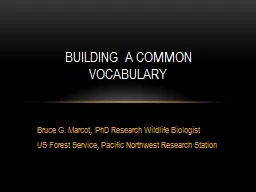

US Forest Service Pacific Northwest Research Station Building a Common Vocabulary model model L modus mode measure model conceptual diagrammatic mathematical computational Hall C A S and J W Day 1977 Systems and models terms and basic principles ID: 603668
Download Presentation The PPT/PDF document "Bruce G. Marcot, PhD Research Wildlife B..." is the property of its rightful owner. Permission is granted to download and print the materials on this web site for personal, non-commercial use only, and to display it on your personal computer provided you do not modify the materials and that you retain all copyright notices contained in the materials. By downloading content from our website, you accept the terms of this agreement.
Slide1
Bruce G. Marcot, PhD Research Wildlife BiologistUS Forest Service, Pacific Northwest Research Station
Building a Common VocabularySlide2
modelSlide3
model
L.
modus
: mode, measureSlide4
model
conceptual
diagrammatic
mathematical
computational
Hall, C. A. S., and J. W. Day. 1977. Systems and models: terms and basic principles.
Pp
. 6-36 in: C. A. S. Hall and J. W. Day,
eds.
Ecosystem modeling in theory and practice. Wiley
Interscience
, New York.Slide5
Modeling Objectives
Source: Marcot, B.G. 2014. General considerations for modeling with probability networks.
Unpub
. report, US Forest Service.Slide6
Modeling Objectives
prediction
(possible future outcomes based on initial conditions)
forecast
(the most
likely future outcome based on initial conditions)
projection
(possible future outcomes based on changing future conditions)
scenario planning
(
peg
the corners of the implications of hypothetical situations)represent knowledge (synthesize what we think we know)
Source: Marcot, B.G. 2014. General considerations for modeling with probability networks.
Unpub
. report, US Forest Service.Slide7
Modeling Objectives
prediction
(possible future outcomes based on initial conditions)
forecast
(the most
likely future outcome based on initial conditions)
projection
(possible future outcomes based on changing future conditions)
scenario planning
(
peg
the corners of the implications of hypothetical situations)represent knowledge (synthesize what we think we know)
identify uncertainties & key data gaps
(identify factors or interactions with the greatest influence on outcomes; sensitivity analysis)
diagnosis
(determine potential causes of a known or specified condition or outcome)mitigation (identify alternative conditions that could lead to a desired outcome)aid individual or collaborative decision-making
Source: Marcot, B.G. 2014. General considerations for modeling with probability networks.
Unpub
. report, US Forest Service.Slide8
Modeling in DecisionsSlide9
Modeling in DecisionsSlide10
Modeling in DecisionsSlide11
Modeling in Decisions
Risk analysis, risk management –
risk = probability x utility
Fuzzy logic v probability –
fuzzy logic = strength of evidence, [-1,+1]
probability = frequency, [0,+1]Slide12
Types of UncertaintySlide13
Types of Uncertainty
Parameter value uncertainty –
-
central tendency values, value distributions
- spatial & temporal variation, interaction terms
Model structure uncertainty –
-
one facet of
epistemic uncertainty
, how the system
is structured and worksInherent system variability –
-
aleatoric
uncertainty
– how a system responds to unknown influences ... hidden or latent variablesSlide14
Testing ModelsSlide15
Testing Models
Calibration –
testing model accuracy against the same data used to build it --
overfitting
Validation –
testing model accuracy against an independent data set
-
k-fold cross-validation
- jackknifing
- leave-one-outSlide16
Personal plea ...Slide17
Personal plea ...
no “emerging” paradigms!Slide18
Personal plea ...Slide19Slide20
Recap ...Slide21
model
conceptual
diagrammatic
mathematical
computational
Hall, C. A. S., and J. W. Day. 1977. Systems and models: terms and basic principles.
Pp
. 6-36 in: C. A. S. Hall and J. W. Day,
eds.
Ecosystem modeling in theory and practice. Wiley
Interscience
, New York.Slide22
Modeling in DecisionsSlide23
Types of Uncertainty
Parameter value uncertainty –
-
central tendency values, value distributions
- spatial & temporal variation, interaction terms
Model structure uncertainty –
-
one facet of
epistemic uncertainty
, how the system
is structured and worksInherent system variability –
-
aleatoric
uncertainty
– how a system responds to unknown influences ... hidden or latent variablesSlide24
Testing Models
Calibration –
testing model accuracy against the same data used to build it --
overfitting
Validation –
testing model accuracy against an independent data set
-
k-fold cross-validation
- jackknifing
- leave-one-outSlide25
This WorkshopSlide26
This Workshop
Landscape scenarios, projectionsSlide27
This Workshop
Landscape scenarios, projections
Fire simulationsSlide28
This Workshop
Landscape scenarios, projections
Climate change
Fire simulationsSlide29
This Workshop
Landscape scenarios, projections
Climate change
Fire simulations
Decision-supportSlide30
This Workshop
Landscape scenarios, projections
Climate change
Fire simulations
Decision-support
Social /
economicsSlide31
This Workshop
Landscape scenarios, projections
Climate change
Fire simulations
Decision-support
Social /
economics
Management –
Wahlberg & Emerson
Departure Analysis, Restoration --
Haugo
Rogue
Basin Restoration --
Metlen
EMDS –
Reynolds &
Hessburg
Landscape Treatment Designer –
Ager
Remote Sensing, Tree Decline –
Grulke
Wildfire Risk Assessment –
Scott